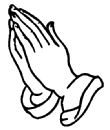

Holy Trinity
Amblecote
This page was suggested by visitors to our website who have found it difficult to find information on this topic.
The catholic tradition of using all the senses in worship also extends to the use of gesture, posture and movement. There is also an old Anglican rule of thumb which says "Stand to praise; kneel to pray; sit to receive instruction."
Standing is seen as a sign of respect and reverence but can also be viewed as an expression of joy, thanksgiving and praise.
Sitting is the posture of meditation, rest and openness. It is most appropriate for the activity of listening.
Kneeling is a gesture of humility, piety, penance and the awareness of our sins. It may also be a gesture of adoration towards, for example, the holy sacrament.
Walking may be viewed as a symbol of pilgrimage.
Prostration is the symbol of total and complete submission and demonstration of vulnerability.
Making the Sign of the Cross
This is perhaps the most well known of all the gestures used in worship. The origins of this gesture may well lie, amongst other things, in the renewal of the Baptismal Cross and its use could be:-
Other occasions when it might be appropriate:-

The Blessing
In the Anglican tradition the Priest may make the sign of the cross when pronouncing the Benediction. There are different positions for the fingers when making the sign of the cross. Index and middle fingers together to represent Christ as God and Man. Index and middle fingers together with thumb pressing down little finger to symbolise the Trinity. The index and middle fingers together with the thumb holding down both ring and little finger to signify Christ as God and Man and also the Trinity.
Shaking of hands at the 'Peace' during the Eucharist is a sign of inclusivity and fellowship, but it is claimed by some writers to be a dumbing down of the ‘Pax’ (the passing down of the embrace of fellowship) a sign of solidarity and love.

Orantes or Orans
The Orantes (orans -
Placing hands together and closing eyes
This is surely the way most of us, as children, were taught that we should pray. The idea being that placing our hands together freed us from distraction and closing our eyes focused us on the task in hand. This is a prayer position widely used in both western and eastern Christianity.


Bowing
This is a sign of respect and gratitude and can be used at the entry and exit of the Cross and Priest. It is used at the name of Jesus in the Creed. To the Thurifer when the congregation is sensed (incense is swung in their direction). Upon entering and leaving the Sanctuary where the Sacrament is reserved; although some people may prefer to genuflect at this point.
Genuflection
This begins from the standing position, the worshipers move their right foot back a step, drop the right knee briefly to the floor, and then return to the standing position. It may be natural to bow the head while performing this action and some make the sign of the cross. This action is purely to honour the presence of Christ in the Sacrament.

Canon Paul Tongue’s booklet ‘Why?’ may prove helpful in explaining the reasons behind some of the things we do or believe.